I’ve lived in the Pacific Northwest long enough to know that if you call a place up here “the sunshine” anything, you’re asking for trouble. I had my doubts about British Columbia’s Sunshine Coast, given how much it rains in the upper left corner of North America, but enough people told me I had to see the area that I took a chance. I’m glad I did, because in addition to sunshine I saw a beautiful city, nature at its finest, and what lies at the end of the road.
I’d heard stories about crossing into Canada that seemed to have originated on different planets—either Canadian border guards were surly and mistrustful, or the nicest minor bureaucrats on earth. My trip to British Columbia began at a customs station where I was asked where I was from, and where I was going and why, and then waved on in before I could even dig my passport out of my tankbag.
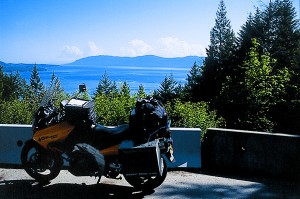
Heading toward Vancouver on Highway 99, I felt as if I’d never left the United States. The posted limit was 100 kph—62 mph—and yet cars whizzed along with distinctly American indifference to it. Lacking even the barest notion of what a Canadian police car looked like, I slowpoked my way to Vancouver where I stayed that night and the next, meeting up with my Canadian buddy Michael, who was in town to have his bike worked on by a local dealer.
I’m not a fan of big cities, but I might be if there were more like Vancouver. The downtown area where we stayed is a mix of old and new architecture, with featureless glass-and-steel monoliths standing shoulder-to-shoulder with handsome old brick buildings with revolving doors and parquet hardwood floors in the elevators. In Gastown, the “old town” section, there’s a steam-powered clock on a street corner that marks the quarter-hour with a few notes from its own version of Big Ben’s song, with more notes added every 15 minutes until the top of the hour when it hoots the entire piece as tourists stand enthralled, cameras clicking.
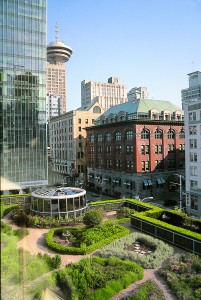
Vancouver sits on the southern shore of Burrard Inlet, and North Vancouver—North Van to the locals—sparkles on the other side, where the buildings climb up the foothills and are backed by craggy, snowcapped mountains. The sea bus plies the waters between them, bringing commuters from mostly residential North Van into the city. The favorable exchange rate—one Canadian dollar to 76 cents U.S. while I was there—allowed us to stay in a hotel so nice I almost bought a Cordura tie to go with my Darien jacket. Nevertheless, everyone I met there seemed to have master’s degrees in laid-back. The hotel even had two dogs on the premises, Holly and Morgan, that guests could check out and take for walks.
Riding in downtown Vancouver wasn’t much different from riding in any city. My Suzuki V-Strom, with its tall seat and high handlebar, made scooting through traffic an effortless if not entirely soothing task, although I had to work hard to keep up with Michael, who tossed his BMW K1100LT around like a motocrosser. The parade of humanity on the sidewalks was diverse and colorful, as were the various ethnic neighborhoods, from which exotic and mouth-watering smells emanated as voices chattered in half the tongues of the world.
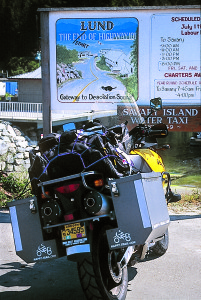
Just to the north of town is Stanley Park, the perfect antidote to too much civilization. Michael and I rode over and joined the throngs of locals and out-of-towners trolling slowly along the road that circles the park. The park boasts an aquarium, a stand of First Nations—Indians to us Americans—totem poles, hiking trails, picnic areas and some spectacular views of the city.
Michael stayed with some Vancouver friends Monday night before heading to the states the next day. Tuesday morning I woke up at an unholy hour with the intention of taking the first ferry of the day from Horseshoe Bay, northwest of the city, to Langdale on the southern end of the Sunshine Coast. I barely made it—I should just start planning on getting lost at least once in every new city I ride in—and missed out on the first-on-first-off deal for motorcycles taking B.C. ferries. Get there at least 10 minutes before departure, and you’ll be waved to the front of the line. Buy your tickets in a group of at least six motorcyclists, and you’ll all get a discount. If you see five riders hanging around outside the ticket booth, that’s why—they’re waiting for a sixth.
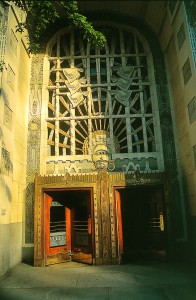
I was last on and parked behind a row of semis, pickups and cars towing boat trailers. The ferry deck was rippled like frost-heaved pavement, and wet with oil and anti-freeze in spots. Signs instructed motorcyclists to park in gear, on the sidestand, and an attendant brought me a wooden wedge to put under the bike and another for the front wheel.
I went up on deck as we got under way. In every direction I looked I saw blue water, mountains carpeted by thick green trees, and jagged peaks capped with snow in the distance. Then the loudspeaker crackled, and the captain announced there was a pod of killer whales off the port side. A giant fin rose up out of the water, glided along, then slipped under the waves. Suddenly a baby orca—if you can imagine a baby the size of a Ford Expedition—breached and rose into the air, curving its body at the top of the arc and nosing back into the water. It’s one thing to see this at Sea World, and quite another thing altogether to see it in the wild. It was so amazing that several passengers actually forgot to take pictures.
Rolling off the ferry at Langdale, I found myself on familiar territory—Highway 101. This serpentine road goes right through the town in Oregon where I live. If one morning I awoke with the notion of following it south as far as I could, my journey would end in Chile. It’s the main, and only, highway connecting the towns on the Sunshine Coast, and in fact there isn’t really much of anywhere else to go except along Highway 101, since there are no other roads into or out of the interior.
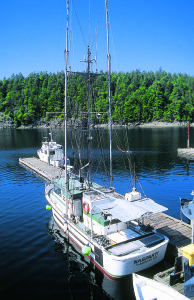
Some friends from Vancouver told me I had to go to Gibsons, the town that was the setting for a long-running Canadian TV show called “The Beachcombers.” There’s a fine little harbor there, and a café or two, but never having seen the show I couldn’t help feeling I was missing something. I was there too early in the day to tour either the Elphinstone Pioneer Museum or the Sunshine Coast Maritime Museum, neither of which would open for a couple of hours yet.
I stopped at a market in Sechelt and bought a breakfast of juice, fruit and a muffin. As I sat on a bench eating, I noticed that no one who drove into the parking lot locked their car. I theorized it was because the only way to get out of town in either direction involved taking a ferry—it’s hard to make a getaway when everyone knows exactly where you’re going, and how you’re going there, and when. Later, while waiting for the ferry from Earls Cove to Saltery Bay, I met a Harley rider and his brother and stepsister who were going to Powell River to settle their late mother’s estate. They told me the people who live on the Sunshine Coast feel isolated due to the time and expense of getting to Vancouver and back. Many like it that way, of course, but even they get rattled whenever there’s an emergency or talk of the ferries going on strike.
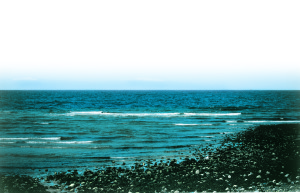
Waiting for the ferries turned out to be one of the most pleasant parts of the ride. There’s a certain calming effect that results from having no other choice but to sit tight and accept that you aren’t going anywhere for a while. People seem to make the most of it, too. One time a waiting passenger took out a violin and began playing an intricate classical piece, which slid gracefully into a mournful dirge and ended with a lively bluegrass medley. Another time a young man sat down on a curb with a guitar and played the blues. At absolutely no point did some dimwit in a car roll down the windows and play the stereo too loud. That, friends, is civilization at its finest.
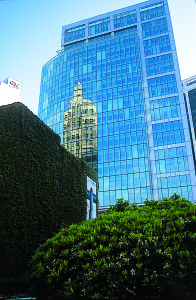
I never got tired of riding along the Sunshine Coast and coming to a stretch with a clear view to the west. Far out in the water would be an island, and behind it another, larger one, and beyond them both in the misty distance the bulk of Vancouver Island, its peaks still topped with snow. There are lots of provincial parks along the way in which to pull over and have a picnic, and for the more adventurous all-day boat excursions up Jervis Inlet to the fjords at Princess Louisa Inlet and Chatterbox Falls.
My second ferry ride of the day took me from the Lower Sunshine Coast to the Upper. Powell River is the only sizable town on this part of the coast. My guidebook described it as “a gritty industrial town,” which struck me as a bit harsh. I saw industry in the form of a huge paper mill and some fishing boats, but little evidence of grit. A ferry runs from Powell River to Blubber Bay on Texada Island, or to Little River near Comox on Vancouver Island. There’s little reason for the causal traveler to go any farther north of town than the ferry terminal, except one—the town of Lund, about a half-hour ride beyond Powell River. A few kilometers later, Highway 101 ends, once and for all.
Really, it just ends. There were some driveways and dirt roads leading off into the woods, but otherwise the road just stopped. To my left was a dock where you could board the Lund Water Taxi for a trip to Savary Island, known as—seriously—“the Hawaii of the north.” Beside the dock was the Lund Hotel, where outdoor tables under umbrellas reminded me it was past lunchtime.
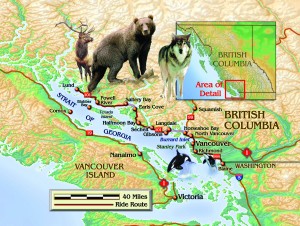
The sun was shining in a cloudless sky, and it was hot enough for me to believe that Hawaii claim. I sat under an umbrella eating the best BLT I’d ever had, watching tiny boats bobbing on the water, behind them as always the vast sweep of Vancouver Island. I’d started the morning in a city where it seemed all roads led, and finished the day in a place where the road literally ended. Just goes to show you that coming to the end of your road isn’t always a bad thing.
(This article North by Northwest was printed in the November 2004 issue of Rider Magazine.)







